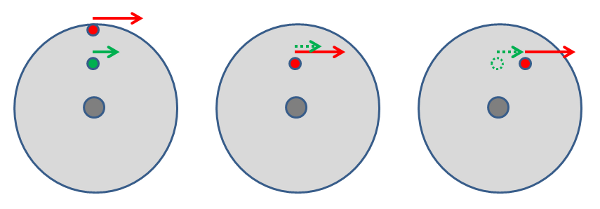The Schenectady JCC, where SteelyKid and The Pip go to day care, has a playground with a merry-go-round on it. How this hasn't been sued out of existence, I have no idea, but it's a great boon to a physics professor. I've used it before to talk about angular momentum, but this weekend I enlisted SteelyKid's help to make a video illustrating a different sort of physics with the merry-go-round, a camera, and a tennis ball:
As you can see in the video, when the merry-go-round isn't moving, the ball rolls straight, but when it's spinning, the ball follows a curved path. This is a striking example of the kind of fake forces Rhett likes to talk about. Specifically, it's a Coriolis force, arising from the fact that the merry-go-round is a non-inertial frame. Everything on the merry-go-round platform is constantly accelerating, changing its direction of motion in order to move in a circle, and because of that an observer sitting on the merry-go-round (say, a video camera on a tripod tied to the frame) will see phenomena that look like an object on the platform is subject to an extra force, even when it's not interacting with anything else.
There are a bunch of ways to approach this, but the easiest is probably to think about it in terms of the velocity, as (crudely) illustrated in the picture below:
If you have a rotating solid object, every point on it has some instantaneous velocity that gets bigger as you move out from the center-- a point on the rim (red dot in the leftmost figure) has to go around the full circumference of the disk every time it completes a rotation, while a point halfway out (green dot) only has to cover half the distance in the same time. Anything that is at rest on the rotating disk will have the same velocity.
If you take an object that's on the disk, though, and move it inward-- say, by rolling a tennis ball toward the center-- it keeps that extra velocity, and as a result will move ahead of an object that started at a smaller distance from the axis. That "moving ahead" in the frame of the rotating disk looks like an extra acceleration that bends the path of the object first in the direction of rotation, and then toward the outside.
And that's exactly what you see in the video above. The direction of motion of the disk is clockwise, as you can see from SteelyKid's pushing on the outer edge of the frame, and the motion of a sneaker I put down to serve as a rotation marker (or the shadows of the posts). The ball starts out moving from left to right, but then curves upward, and then back to the left, eventually falling off the edge. That's the effect of the Coriolis force on a moving object in a rotating frame.
This isn't just a playground curiosity, either-- the most famous example of the Coriolis force is the motion of hurricanes, whose winds spiral in one direction in the Northern hemisphere, and the opposite direction in the Southern. That's due in large part to exactly this effect-- the Earth rotates under air moving to the north or south in a way that causes it to appear to move east or west to an observer fixed on the surface of the rotating planet.
And if you can find a playground with a merry-go-round on it, you can see this physics in action for yourself.
For homework, you can use the video and the formula for Coriolis acceleration on that Wikipedia page to check the behavior. The ball used for this is a standard tennis ball, and the frame rate was apparently 15 frames/second (the tripod fell over on the first attempt, and hitting the ground changed some camera settings that I didn't notice at the time; that's also why the colors appear a little odd-- it's in some high-dynamic-range mode). You've got enough information there to use a program like Tracker Video Analysis to figure out the velocity of the ball and the rate of rotation, and see if the observed acceleration matches.
(Send your calculations to Rhett for grading. Make sure you show all your work.)


I always thought the most famous example of the Coriolis force concerned events of the first battle of the Falkland Islands (during WW I) that appears as a footnote in Goldstein (IIRC). The fancy aiming system of a state-of-the-art British battleship missed BADLY during that battle and they had to go back to trial and error aiming. They checked the guns on a firing range when they got back home, and they were working fine ... at 40 N. They were shooting at 40 S.
Weather is the most familiar example. ;-)
By the way, your next challenge is to play catch with yourself to the annoyance of SteelyKid on the opposite side while your wife films it all. That was always the highlight of "Frames of Reference" starring two crazy Canadian physicists. The folks who made the video that was in YouTube's "related" list with yours managed to pull it off.
http://www.youtube.com/watch?v=_36MiCUS1ro
I thought those contraptions were "wrist/clavicle breaking machines". I'm amazed you still have one, but I agree it is a physics teacher's friend.
The other one that still has a place in county fairs is the "round-up" ride. Most of Chapter 8 is in there.